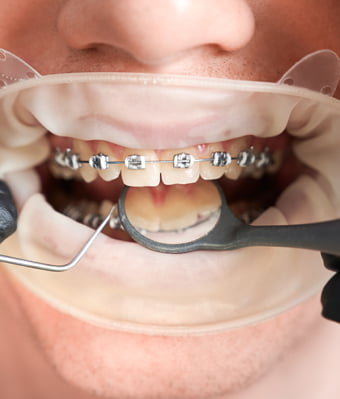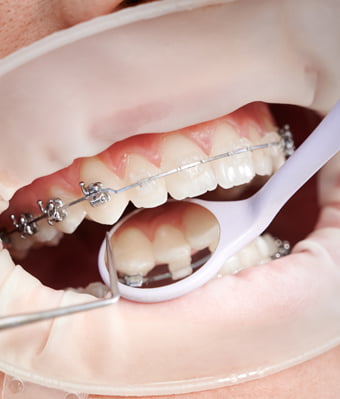Orthodontics
Thanks to orthodontic treatments, you can have a healthy and symmetrical tooth and jaw structure. Read this article to learn about orthodontic treatments.

What is Orthodontics?
Orthodontics is a branch of science that deals with the treatment of dental, facial and jaw disorders. Orthodontic treatment helps the jaw development of children at an early age and ensures that the teeth are in the correct positions. In adult patients, it treats distortions or closing disorders that occur in the teeth. It conducts joint studies with other branches of dentistry in the treatment of congenital or subsequent facial and jaw disorders.
How is Orthodontic Treatment Performed?
Orthodontic treatment is performed with the help of fixed or removable devices applied to the jawbone or tooth.
Metal Brackets
The most preferred orthodontic devices are metal brackets. Metal brackets are glued on the teeth. Thanks to the wires passing between these brackets, the teeth move and eventually reach the desired position.
Transparent Brackets
There are also different treatment options for people who do not like the look of braces or do not want braces to appear when talking. Transparent brackets are one of them. They are made of tooth-colored or completely transparent material. They work on the same principle as metal brackets. The only difference between transparent brackets and metal ones is that they are less noticeable. Having a tooth color or a transparent color makes them less visible. For this reason, it is usually preferred by adult patients.
Lingual Brackets
Lingual brackets are the name given to fixed metal brackets that are glued to the inner surface of the tooth. It is not visible from the outside because it is glued to the inner surface. Compared to metal brackets, the treatment takes longer. It is preferred by adults because it is never seen from the outside.
Radio Orthodontic Treatments
Radio-assisted orthodontic treatments are performed using a transparent plaque. Teeth are corrected thanks to transparent plaques that will not be visible when viewed from the outside. Transparent plaques are removed while eating or brushing teeth. Other times he’s always hanging out. Transparent plaques are used only for people with distortions in their teeth. This treatment is not used for disorders of the jaw and facial system.
Why Should We Have Orthodontic Treatment?
Many people consult an orthodontist to make their teeth look more symmetrical. However, orthodontic treatments are not performed solely with the concern of appearance. Crooked teeth can cause closing disorders (Malocclusion), chewing or speech disorders.
It is more difficult to maintain oral hygiene with crooked teeth. Therefore, bruises form more easily. Plaque accumulation occurs between Decayed teeth that cannot be cleaned, which can lead to gum retraction or gum disease.
Deformities in the teeth prevent mouth closure. This can also cause various joint problems. Any trauma that may occur, especially in people whose upper teeth are further ahead than they should be, or whose upper jaw is further ahead (falling or being hit by a ball), will affect the front teeth more easily.
The presence of excessive Decussation between the upper and lower front teeth prevents the correct pronunciation of some sounds. This can also cause slurred speech.
We can think of orthodontic treatments in children as a vaccine. With early orthodontic interventions, ailments that may occur from tooth distortion in the future are prevented. Children’s risk of developing jaw and dental diseases in the later stages decreases.
How Old Does Orthodontic Treatment Start?
Dairy work in children is completed at about 2.5 years of age. Permanent teeth are completed at about 12 years of age. Some jaw disorders may require early treatment at the age of 7-8 years. If there is only a distortion in the teeth, permanent teeth should be expected to be completed.


What is the Oldest Age for Braces?
There is no age limit for orthodontic treatments for adults. No matter how old you are, you can get orthodontic treatment. Braces are not only worn by children or teenagers. Braces treatment can be applied to adults of all ages.
How Long is the Duration of Orthodontic Treatments?
How long the process of orthodontic treatments varies from person to person. Orthodontic treatment performed only for crooked teeth takes less time than in cases requiring additional October treatment. The duration of dental treatment also varies depending on the degree of distortion of the teeth. The treatment lasts between 6 months and 24 months on average. Dec. In some patients, this period may increase even more. In order not to prolong the treatment period, the patient should follow the doctor’s recommendations. He should take care of dental and gum health. He should stay away from foods and drinks that should be avoided.
How Painful is Orthodontic Treatment?
A bracket is attached to the tooth and the pain is not felt. In people with braces, it takes 7-10 days for the teeth to get used to braces. During this process, pressure and pain may be felt in the teeth. This is usual. Since the wires in your teeth will change during routine checkups, you may experience pain for a short period of time after the checkup.
What is the Best Way to Clean Braces?
Food residues and plaque formation around the brackets are quite easy. The most important thing to pay attention to in keeping the braces clean is to clean the teeth immediately after eating. Jul. After brushing the teeth, it should be checked whether the brackets are carefully cleaned around them. Dental floss should be used to keep the brackets clean around them.Jul.
What to Avoid Right After Getting Braces?
- Great attention should be paid to oral and dental care.
- Hard, acidic or sticky foods and beverages should be avoided.
- It should be avoided in dangerous situations that may cause a blow to the mouth and its surroundings. Extra attention should be paid when playing sports.
What Foods to Avoid After Getting Braces?
Things that should not be eaten after having braces can be listed as follows;
- Acidic drinks such as soda or cola,
- Chewing gum, Turkish delight, etc. sticky foods,
- Hard foods (apples, pears, etc.),
- It is not recommended to eat foods such as chips and popcorn.

